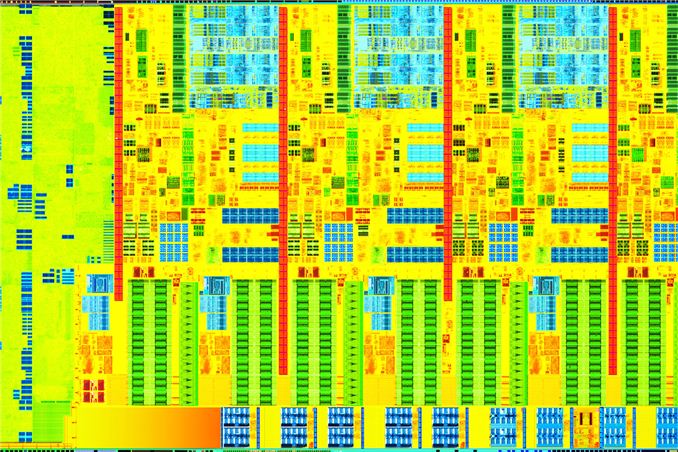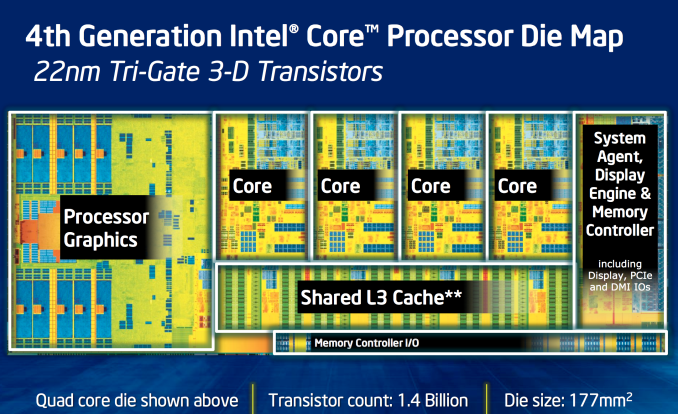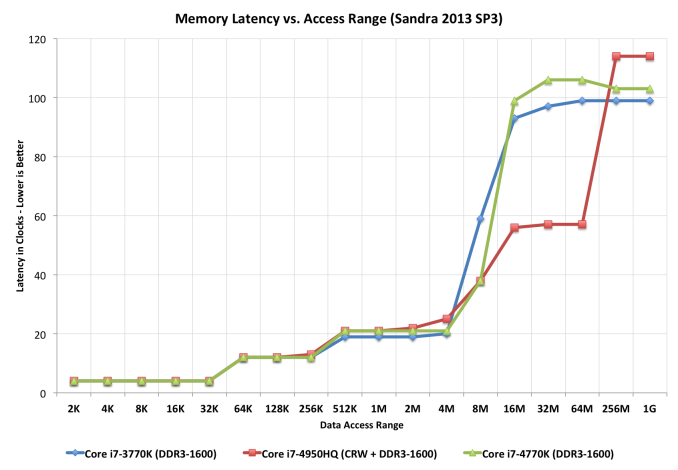The Haswell Review: Intel Core i7-4770K & i5-4670K Tested
by Anand Lal Shimpi on June 1, 2013 10:00 AM EST
This is a very volatile time for Intel. In an ARM-less vacuum, Intel’s Haswell architecture would likely be the most amazing thing to happen to the tech industry in years. In mobile Haswell is slated to bring about the single largest improvement in battery life in Intel history. In graphics, Haswell completely redefines the expectations for processor graphics. There are even some versions that come with an on-package 128MB L4 cache. And on the desktop, Haswell is the epitome of polish and evolution of the Core microprocessor architecture. Everything is better, faster and more efficient.
There’s very little to complain about with Haswell. Sure, the days of insane overclocks without touching voltage knobs are long gone. With any mobile-first, power optimized architecture, any excess frequency at default voltages is viewed as wasted power. So Haswell won’t overclock any better than Ivy Bridge, at least without exotic cooling.
You could also complain that, for a tock, the CPU performance gains aren’t large enough. Intel promised 5 - 15% gains over Ivy Bridge at the same frequencies, and most of my tests agree with that. It’s still forward progress, without substantial increases in power consumption, but it’s not revolutionary. We compare the rest of the industry to Intel’s excellent single threaded performance and generally come away disappointed. The downside to being on the top is that virtually all improvements appear incremental.
The fact of the matter is that the most exciting implementations of Haswell exist outside of the desktop parts. Big gains in battery life, power consumption and even a broadening of the types of form factors the Core family of processors will fit into all apply elsewhere. Over the coming weeks and months we’ll be seeing lots of that, but today, at least in this article, the focus is on the desktop.
Haswell CPU Architecture Recap
Haswell is Intel’s second 22nm microprocessor architecture, a tock in Intel’s nomenclature. I went through a deep dive on Haswell’s Architecture late last year after IDF, but I’ll offer a brief summary here.
At the front end of the pipeline, Haswell improved branch prediction. It’s the execution engine where Intel spent most of its time however. Intel significantly increased the sizes of buffers and datastructures within the CPU core. The out-of-order window grew, to feed an even more parallel set of execution resources.
Intel added two new execution ports (8 vs 6), a first since the introduction of the Core microarchitecture back in 2006.
On the ISA side, Intel added support for AVX2, which includes an FMA operation that considerably increases FP throughput of the machine. With a doubling of peak FP throughput, Intel doubled L1 cache bandwidth to feed the beast. Intel also added support for transactional memory instructions (TSX) on some Haswell SKUs.
The L3 cache is now back on its own power/frequency plane, although most of the time it seems to run in lockstep with the CPU cores. There appears to be a 2 - 3 cycle access penalty as a result of decoupling the L3 cache.


















210 Comments
View All Comments
klmccaughey - Monday, June 3, 2013 - link
AMD are a damn sight closer on Nvidia than they are to Intel, though still sandbagging for this year. It's a bad year for us upgraders!aCuria - Saturday, June 1, 2013 - link
This review needs a compilation speed test against the 3930k, I would really like to know if haswell could edge out the 3930k in that testKevin G - Saturday, June 1, 2013 - link
Haswell met expectations in terms of IPC increases and power reductions. Both of those are good things overall. However, I feel disappointed and that comes down to how Intel has segregated their product line up: GT3e and TSX are only available on select parts. Ideally on the high end I'd like to get a socketed chip with an unlocked multiplier, GT3e, TSX, and Hyperthreading. Of those five criteria, at best I can get three of those. I suspect that this is due to Intel keeping several possible configurations reserved for their Xeon lineup but those chips won't have an unlocked multiplier.I'm currently an owner of a Sandybridge i7-2600K and the current performance of the Haswell parts aren't that tempting to jump the configurations Intel is selling. So I'm left waiting another year for a future desktop refresh before making the jump. Oh wait, Broadwell is going to be strictly a mobile refresh (and possibly a desktop BGA) refresh. So the best upgrade path for me for the next couple of years is to wait for a cheap i7-3770K on clearance. Otherwise the price/performance gains are radically higher as to not be worth it (also would need to get a new motherboard for socket 1150). I guess I'm left waiting for Skylake, get lucky that Intel adds several SKU's that I want or see what AMD can produce for the desktop.
Khato - Saturday, June 1, 2013 - link
Just curious as to your source for TSX only being available on select parts? The only place I saw that was on the Tom's Hardware preview. It's not in any of the reviews that I've seen?amock - Saturday, June 1, 2013 - link
According to http://ark.intel.com/products/75123/Intel-Core-i7-... the 4770k doesn't have TSX support.Kevin G - Saturday, June 1, 2013 - link
Intel is likely keeping TSX away from any desktop part with eDRAM. I suspect that having a massive L4 cache and TSX may make these quadcore chips very competitive with some of their socket 2011 parts based upon Sandy bridge/Ivy Bridge cores. These would happen in heavily memory bound applications like some database operations tend to be. Intel hasn't updated ARK with all of the Haswell chips yet so I'm be curious to see if their will be a mobile part with GT3e + TSX. I'd love it if some enterprise DB's supporting TSX were tested on this platform to see if this idea pans out.smilingcrow - Saturday, June 1, 2013 - link
The i5/i7 K series socketed desktop chips don't have eDRAM anyway so that's a moot point; they both lack TSX support.Kevin G - Monday, June 3, 2013 - link
Well it does look like that the L4 cache in GT3e parts can make Haswell competitive with socket 2011 six core chips. Check out the i7 4950hq results from Tech Report's Euler 3D fluid dynamics tests:http://techreport.com/review/24879/intel-core-i7-4...
The i7 4950 was likely seeing a strong benefit from an open air test bed (it is a mobile part) so I suspect that it can reach its 3.4 Ghz four core turbo relatively often. I still would expect slightly better performance if the 2.4 Ghz base clock was raised. The i7 4950 is further handicapped as the L3 cache was cut down to 6 MB and was using SO-DIMM memory with loose timings. The kicker is that this is with legacy code with any AVX2, FMA or TSX benefits.
I really, really want an unlocked, noncripppled socket 1150 part with GT3e.
just4U - Sunday, June 2, 2013 - link
Well.. your already on a i7.. and tbh I'd say the 2600K is better than the 3770K. .I purchased a 2700K even though the 3770K was out. Why? Well.. lower heat and miniscule gains in the 3X line.. plus when I decide to OC I'll likely get more out of my chip (as will you..) than they get on the IvyBridge processors.Kevin G - Monday, June 3, 2013 - link
I currently have my i7 2600K running at a conservative 4.2 Ghz. I've gotten it to boot at 4.6 Ghz with ease and probably could go further if felt like increasing voltages and got better cooling (though it is in a 4U server case so cooling options are a bit more limited).Price drops are happening for the i7 3770K. Probably need to wait a bit more and might pick one up if they drop further. Microcenter has dropped them to $230 already.